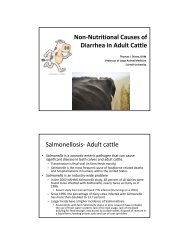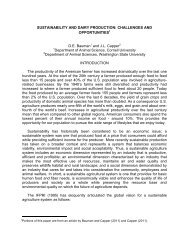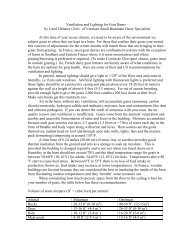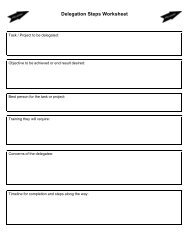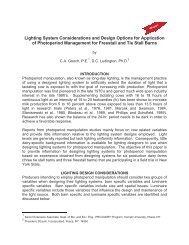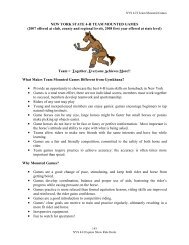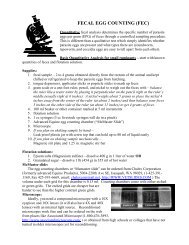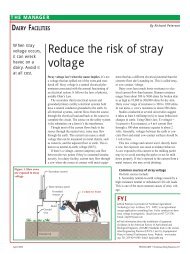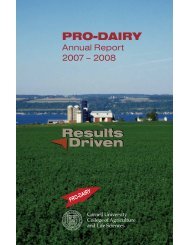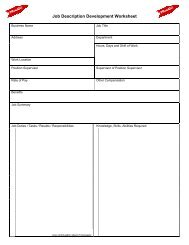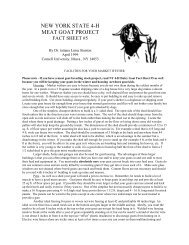Net Present Value Economic Analysis Model for Adoption of ...
Net Present Value Economic Analysis Model for Adoption of ...
Net Present Value Economic Analysis Model for Adoption of ...
You also want an ePaper? Increase the reach of your titles
YUMPU automatically turns print PDFs into web optimized ePapers that Google loves.
<strong>Net</strong> <strong>Present</strong> <strong>Value</strong> <strong>Economic</strong> <strong>Analysis</strong> <strong>Model</strong> <strong>for</strong> <strong>Adoption</strong> <strong>of</strong><br />
Photoperiod Manipulation in Lactating Cow Barns<br />
by<br />
Roberta L. Crill 1<br />
John J. Hanchar 2<br />
Curt A. Gooch, P.E. 3<br />
Steven T. Richards 4<br />
Introduction<br />
Photoperiod manipulation or long-day lighting (LDL), the practice <strong>of</strong> using a designed<br />
lighting system to artificially extend daylight hours to increase milk production in<br />
lactating dairy cows, started in the late 1970’s and gained acceptance in the late 1990’s.<br />
The increased light period decreases the secretion <strong>of</strong> melatonin and triggers the liver to<br />
increase production <strong>of</strong> insulin-like growth factor (IGF-1), which increases milk yield<br />
(Dahl, 2000). Supplementing lactating cows with 16 to 18 hours <strong>of</strong> light increases milk<br />
yield from 5 to 16% above cows exposed to less than 13.5 hours <strong>of</strong> light (Peters et al.,<br />
1978, 1981; Marcek and Swanson, 1984; Stanisiewski et al., 1985; Bilodeau et al.,<br />
1989; Phillips and Sch<strong>of</strong>ield, 1989). These increases are similar to increases realized<br />
from other management practices used in the dairy industry to increase milk production<br />
from lactating cows – <strong>for</strong> example, milking three times a day and the use <strong>of</strong> rbST.<br />
Recent research reported that extended light period, rbST, and three times a day<br />
milking were additive and produced 9.0 lbs per cow (Dahl, 2001).<br />
Numerous trials have looked at the animal response, but few studies have examined<br />
the economic worth associated with LDL technology. The first to address the economic<br />
aspects <strong>of</strong> this technology were Dahl and his colleagues (Dahl 1999 & 2001). Their<br />
economic model and analysis determines the payback period <strong>for</strong> the technology. Their<br />
work is an application <strong>of</strong> the payback period method. This analysis method does not<br />
address the economic worth <strong>of</strong> the investment over its expected useful life, or time<br />
value <strong>of</strong> money considerations associated with investments in capital items (Casler,<br />
Anderson, and Aplin, 1993). The work described here adopts net present value (NPV),<br />
discounted cash flow, to examine the economic worth <strong>of</strong> this technology, avoiding the<br />
limitations <strong>of</strong> other measures <strong>of</strong> investment worth.<br />
1 Extension Associate, Northwest New York Dairy, Livestock, and Field Crops Team, Cornell University,<br />
Cornell Cooperative Extension, PRO-DAIRY, P.O. Box 748, Waterloo, NY 13165, rlc32@cornell.edu.<br />
2 Extension Associate, Northwest New York Dairy, Livestock, and Field Crops Team, Cornell University,<br />
Cornell Cooperative Extension, PRO-DAIRY, 158 Main Street, Mt. Morris, NY 14510, jjh6@cornell.edu.<br />
3 Senior Extension Associate, Biological and Environmental Engineering Department, PRO-DAIRY,<br />
Cornell University, Ithaca, NY 14853, cag26@cornell.edu.<br />
4 Director, Extensions Associate, NYS FarmLink Program, Cornell University, Ithaca, NY 14853,<br />
str4@cornell.edu.
The NPV method serves as the framework <strong>for</strong> an electronic spreadsheet that can be<br />
used by farm managers and their advisors <strong>for</strong> decision making. Differences in initial<br />
capital investment required due to design requirements, potential response in milk<br />
production, ration costs, and electricity prices among other key independent variables<br />
pointed to the need <strong>for</strong> a tool that could be applied using in<strong>for</strong>mation specific to<br />
individual farms. In addition, the potential <strong>for</strong> variability in key variables on an individual<br />
farm pointed to the need <strong>for</strong> a model that could be readily used by the decision maker<br />
<strong>for</strong> the purposes <strong>of</strong> conducting sensitivity analyses. Sensitivity analysis measures the<br />
impact <strong>of</strong> changing one or more key input values about which there is uncertainty<br />
(Marshall, 1999). The purposes <strong>of</strong> this paper are as follows: 1) to describe the NPV<br />
electronic spreadsheet model developed to evaluate the adoption <strong>of</strong> LDL technology,<br />
and 2) to illustrate its application using farm data obtained from two commercial dairy<br />
farm businesses.<br />
Materials and Methods<br />
<strong>Net</strong> <strong>Present</strong> <strong>Value</strong> Method<br />
The NPV or discounted cash flow method is a preferred method <strong>for</strong> evaluating the<br />
economic worth <strong>of</strong> an investment, because the method considers the time value <strong>of</strong> the<br />
entire stream <strong>of</strong> net cash flows over the life <strong>of</strong> the investment (Casler, Anderson, and<br />
Aplin, 1993). NPV analysis is based on the concept that a dollar received today is<br />
preferred to a dollar received at some future date. The NPV <strong>of</strong> an investment is the<br />
sum <strong>of</strong> the present values <strong>for</strong> each year’s net cash flow less the initial costs <strong>of</strong> the<br />
investment. Use <strong>of</strong> the NPV method requires estimating expected changes in net cash<br />
flow <strong>for</strong> each year <strong>of</strong> useful life using marginal approaches such as partial budgeting<br />
(Kay, 1981). Management should strongly consider implementing the investment to the<br />
farm business when the investment has a positive NPV. An NPV greater than zero<br />
implies an actual rate <strong>of</strong> return on the investment that is greater than the discount rate<br />
used, the minimum acceptable rate <strong>of</strong> return that must be earned by a capital<br />
expenditure. We use the weighted average cost <strong>of</strong> capital as the discount rate. The<br />
weighted average cost <strong>of</strong> capital considers the cost <strong>of</strong> capital funds from each source<br />
employed by the business, and the relative proportion <strong>of</strong> each source <strong>of</strong> capital given a<br />
firm’s desired capital structure (Casler, Anderson, and Aplin, 1993).<br />
NPV Electronic Spreadsheet <strong>for</strong> Evaluating Long-Day Lighting<br />
An electronic spreadsheet incorporating NPV methods requires users to input a variety<br />
<strong>of</strong> data <strong>for</strong> the purpose <strong>of</strong> tailoring analyses to a farm. Users provide the initial capital<br />
investment required, type <strong>of</strong> system including numbers <strong>of</strong> fixtures by type, milk price,<br />
expected change in milk production per cow with implementation <strong>of</strong> LDL, cost <strong>of</strong><br />
hauling, feed cost, and expected hours <strong>of</strong> use among others. The spreadsheet<br />
calculates the NPV associated with proposed investment in LDL technology based upon<br />
a partial budget analysis that calculates changes in cash flows. A free copy <strong>of</strong> this<br />
electronic spreadsheet can be downloaded at http://www.cce.cornell.edu/programs/nwny-dairy-fieldcrops/RobertasDairyUpdate.htm.<br />
2
The NPV model assumes that added cash inflows and outflows are the same <strong>for</strong> each<br />
year <strong>of</strong> the ten-year expected economic life <strong>of</strong> the lighting system except <strong>for</strong> year one<br />
when added outflows include the initial capital cost associated with the investment. In<br />
addition, fixture ballasts use energy in amounts that are approximately 5 to 15 percent<br />
<strong>of</strong> the energy used by the bulbs alone. There<strong>for</strong>e, since watts per bulb are the input in<br />
the model, energy use <strong>for</strong> the entire fixture, bulbs and ballasts included, equals the<br />
energy use <strong>for</strong> the bulbs plus 10 percent.<br />
The partial budget analysis within the electronic spreadsheet considers added cash<br />
inflows and added cash outflows associated with the adoption <strong>of</strong> LDL technology.<br />
Based upon current knowledge <strong>of</strong> the technology, the analysis does not consider<br />
reduced cash inflows and reduced cash outflows, although the capacity is present to do<br />
so. Added cash inflows from additional milk receipts due to expected increases in milk<br />
production per cow characterize the analysis. The analysis considers added cash<br />
outflows due to the initial capital cost <strong>of</strong> the system (including installation), feed costs,<br />
promotion cost, hauling costs, milk handling costs (cooling and labor on farm), electricity<br />
cost, and maintenance costs associated with the lighting system.<br />
Farm Data<br />
To demonstrate the NPV model, owners <strong>of</strong> two commercial dairy farm businesses<br />
where the LDL technology has been adopted shared milk response, cost and other data<br />
with us. (For further in<strong>for</strong>mation see ASAE Paper #024205, Lighting System<br />
Considerations and Design Options <strong>for</strong> Application <strong>of</strong> Photoperiod Manipulation<br />
Management <strong>for</strong> Freestall and Tie Stall Barns). Table 1 highlights the variables used in<br />
the NPV spreadsheet model and individual input values from the two farms. The total<br />
system costs including installation <strong>for</strong> Farm 1, an 80-cow tie stall facility, and Farm 2, a<br />
210-cow freestall facility, were $3,559.80 and $14,878.00 respectively.<br />
Table 1. Variables Used in the NPV <strong>Model</strong> With <strong>Value</strong>s.<br />
Variable Costs Farm 1 Data Farm 2 Data<br />
Average Number <strong>of</strong> Lactating Cows 80 210<br />
Months/Year <strong>of</strong> Supplemental Lighting 12 12<br />
Milk Response (lbs per day per cow) 5 5<br />
Milk Price per cwt $12.81 $13.01<br />
Cost <strong>of</strong> Hauling per cwt $0.39 $0.35<br />
Cost <strong>of</strong> Promotion per cwt $0.15 $0.15<br />
Ration Cost - $ per pound <strong>of</strong> feed $0.055 $0.0786<br />
Hours/day <strong>of</strong> Operation 18 18<br />
Average Energy Cost - $ per kW-hr $0.082 $0.115<br />
Weighted Average Cost <strong>of</strong> Capital, discount rate 7.0% 7.0%<br />
Results and Discussion<br />
<strong>Net</strong> present values <strong>for</strong> the ten-year expected economic life <strong>of</strong> the LDL technology <strong>for</strong><br />
Farm 1 and Farm 2 were $56,990 and $28,915, respectively. Applying the decisionmaking<br />
criterion described above suggests that investment in the LDL technology would<br />
be attractive to owners <strong>of</strong> both dairy farm businesses given the initial data and<br />
assumptions.<br />
3
Due to expected greater variability in milk response and electricity costs per unit, a<br />
sensitivity analyses was conducted using the model. Results <strong>of</strong> sensitivity analyses <strong>for</strong><br />
Farm 1, (reported in Table 2) suggest that LDL becomes an undesirable investment <strong>for</strong><br />
that farm only when expected milk response decreases to one pound per cow per day<br />
and electricity costs rise to $0.12 per kW-hr or higher.<br />
Results from sensitivity analyses <strong>for</strong> Farm 2 (reported in Table 3) suggest that LDL<br />
becomes an undesirable investment over a wider range <strong>of</strong> milk response and electricity<br />
costs per unit when compared to Farm 1. For example, at current electricity costs per<br />
unit <strong>of</strong> $0.115 per kW-hr, Farm 2 must make about four pounds <strong>of</strong> milk per cow per day<br />
<strong>for</strong> the investment to be desirable. If milk response falls to 3 pounds per cow per day,<br />
then NPV is negative and the investment is undesirable given the discount rate and<br />
other inputs.<br />
Differences in the values <strong>of</strong> key variables between the two farms help to explain relative<br />
differences in results between each. Farms differed with respect to milk price, hauling<br />
costs, ration costs, and energy costs. Farm 2 had higher values <strong>for</strong> three <strong>of</strong> these four<br />
variables when compared to Farm 1. At initial values, investment in LDL technology<br />
produced a NPV <strong>of</strong> $56,990 or $712 per cow <strong>for</strong> Farm 1. In contrast, although Farm 2<br />
earned approximately $0.20 more per hundredweight <strong>of</strong> milk, adoption <strong>of</strong> the technology<br />
resulted in a net present value <strong>of</strong> $28,915 or $138 per cow due to the effects <strong>of</strong> other<br />
variables. Results highlight the sensitivity <strong>of</strong> the decision to individual farm values and<br />
demonstrate the importance <strong>of</strong> farm specific evaluation <strong>of</strong> this technology using the<br />
NPV analysis <strong>of</strong> the electronic spreadsheet described herein.<br />
Table 2. Farm 1 Sensitivity Analyses <strong>for</strong> <strong>Net</strong> <strong>Present</strong> <strong>Value</strong>s by Milk Response and Electricity<br />
Costs.<br />
Energy Cost - $ per kW-hr<br />
Milk (lbs) 0.04 0.06 0.08 0.10 0.12 0.14<br />
1 $3,818 $2,691 $1,564 $437 ($689) ($1,816)<br />
2 $17,703 $16,576 $15,449 $14,322 $13,195 $12,068<br />
3 $31,587 $30,460 $29,334 $28,207 $27,080 $25,953<br />
4 $45,472 $44,345 $43,218 $42,091 $40,964 $39,838<br />
5 $59,357 $58,230 $57,103 $55,976 $54,849 $53,722<br />
Table 3. Farm 2 Sensitivity Analyses <strong>for</strong> <strong>Net</strong> <strong>Present</strong> <strong>Value</strong>s by Milk Response and Electricity<br />
Costs.<br />
Energy Cost - $ per kW per hour<br />
Milk (lbs) 0.04 0.06 0.08 0.10 0.12 0.14<br />
1 ($32,542) ($42,856) ($53,170) ($63,485) ($73,799) ($84,114)<br />
2 ($7,508) ($17,822) ($28,137) ($38,451) ($48,765) ($59,080)<br />
3 $17,526 $7,212 ($3,103) ($13,417) ($23,732) ($34,046)<br />
4 $42,560 $32,246 $21,931 $11,617 $1,302 ($9,012)<br />
5 $67,594 $57,280 $46,965 $36,651 $26,336 $16,022<br />
Conclusion<br />
Farm business managers should evaluate the adoption <strong>of</strong> new technologies that require<br />
capital investment using appropriate methods <strong>of</strong> investment analysis. The NPV<br />
4
electronic spreadsheet <strong>for</strong> evaluating photoperiod manipulation enhances a manager’s<br />
ability to evaluate the economic worth <strong>of</strong> the technology on an individual farm basis.<br />
Each farm business can expect differences with respect to added cash inflows and<br />
reduced cash outflows. The sensitivity <strong>of</strong> the model to variables differed between<br />
farms, but key variables that influenced the model the greatest included milk response,<br />
the cost <strong>of</strong> energy, and additional ration costs.<br />
Acknowledgements<br />
Dr. Wayne Knoblauch, Cornell University <strong>for</strong> reviewing and improving the economic<br />
model.<br />
References<br />
Bilodeau, P.P., D. Petiticlerc, N. St. Pierre, G. Pelletier, and G.J. St. Laurent. 1989.<br />
Effects <strong>of</strong> photoperiod and pair-feeding on lactation <strong>of</strong> cows fed corn or barley<br />
grain in total mixed rations. J. Dairy Sci. 72:2999.<br />
Casler, G. L., B. L. Anderson and R. D. Aplin. 1993. Capital Investment <strong>Analysis</strong>: Using<br />
Discounted Cash Flows. 5th ed. Ithaca, NY: Cornell University.<br />
Dahl, G.E., J. Baltz, and A. Hager. 2001. Illini Photoperiod Calculator Version 1.01.<br />
University <strong>of</strong> Illinois at Urbana-Champaign. Available at: www:<br />
http://il-traill.outreach.uiuc.edu/photoperiod/ Accessed January 2002.<br />
Dahl, G.E., R. Peters, and S. Brown. 1999. University <strong>of</strong> Marland Photoperiod Web<br />
Site. University <strong>of</strong> Maryland. Unavailable at present time: Accessed April 2000.<br />
Dahl, G.E., J.P. Chastain, and R.R. Peters. 1997. Manipulation <strong>of</strong> photoperiod to<br />
increase milk production in cattle: Biological, economic and practical<br />
considerations. :259.<br />
Dahl, G.E. 1998. Photoperiod. In 4 th International Dairy Housing Conference<br />
Proceedings, 271-284. T. Smith and R. Jones, eds. St. Joseph, Mich.: ASAE<br />
Dahl, G. E., T. H. Elsasser, A. V. Capuco, R. A. Erdman, and R. R. Peters. 1997.<br />
Effects <strong>of</strong> long day photoperiod on milk yield and circulating insulin-like growth<br />
factor-1. Journal <strong>of</strong> Dairy Science 80:2784-2789.<br />
Kay, R. D. 1981. Farm Management: Planning, Control, and Implementation. New<br />
York, NY: McGraw-Hill Book Company.<br />
Marcek, J.M. and L.V. Swanson. 1984. Effect <strong>of</strong> photoperiod on milk production and<br />
prolactin <strong>of</strong> Holstein dairy cows. J. Dairy Sci. 67:2380.<br />
Marshall, H.E. 1999. Sensitivity <strong>Analysis</strong>. In Technology Management Handbook, 59-<br />
63. R.C. Dorf, Ed. Baca Raton, FL: CRC Press LLC<br />
Peters, R.R., L.T. Chapin, R.S. Emery, and H.A. Tucker. 1981. Milk yield, feed intake,<br />
prolactin, growth hormone, and glucocorticoid response <strong>of</strong> cows to supplemental<br />
light. J. Dairy Sci. 64:1671.<br />
Peters, R.R., L.T. Chapin, K.B. Leining, and H.A. Tucker. 1978. Supplemental lighting<br />
stimulates growth and lactation in cattle. Science 199:911.<br />
Phillips, C.J.C., and S.A. Scholfield. 1989. The effect <strong>of</strong> supplemental light on the<br />
production and behavior <strong>of</strong> dairy cows. Anim. Prod. 48:293.<br />
Stanisiewski, E.P., R.W. Mellenberger, C.R. Anderson, and H.A. Tucker. 1985. Effect<br />
<strong>of</strong> photoperiod on milk yield and milk fat in commercial dairy herds. J. Dairy Sci.<br />
68:1134.<br />
5
Tucker. H.A. 1992. Manipluation <strong>of</strong> photoperiod to improve lactation, growth, and<br />
reproduction. Large Dairy Herd Management. H.H. Van Horn and C.J. Wilcox,<br />
eds. Amer. Dairy Sci. Assoc., Champaign, IL.<br />
Appendix or Nomenclature<br />
NPV = <strong>Net</strong> <strong>Present</strong> <strong>Value</strong><br />
LDL = Long-day Lighting<br />
6



